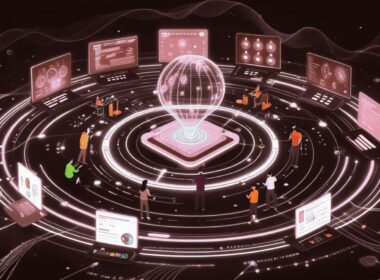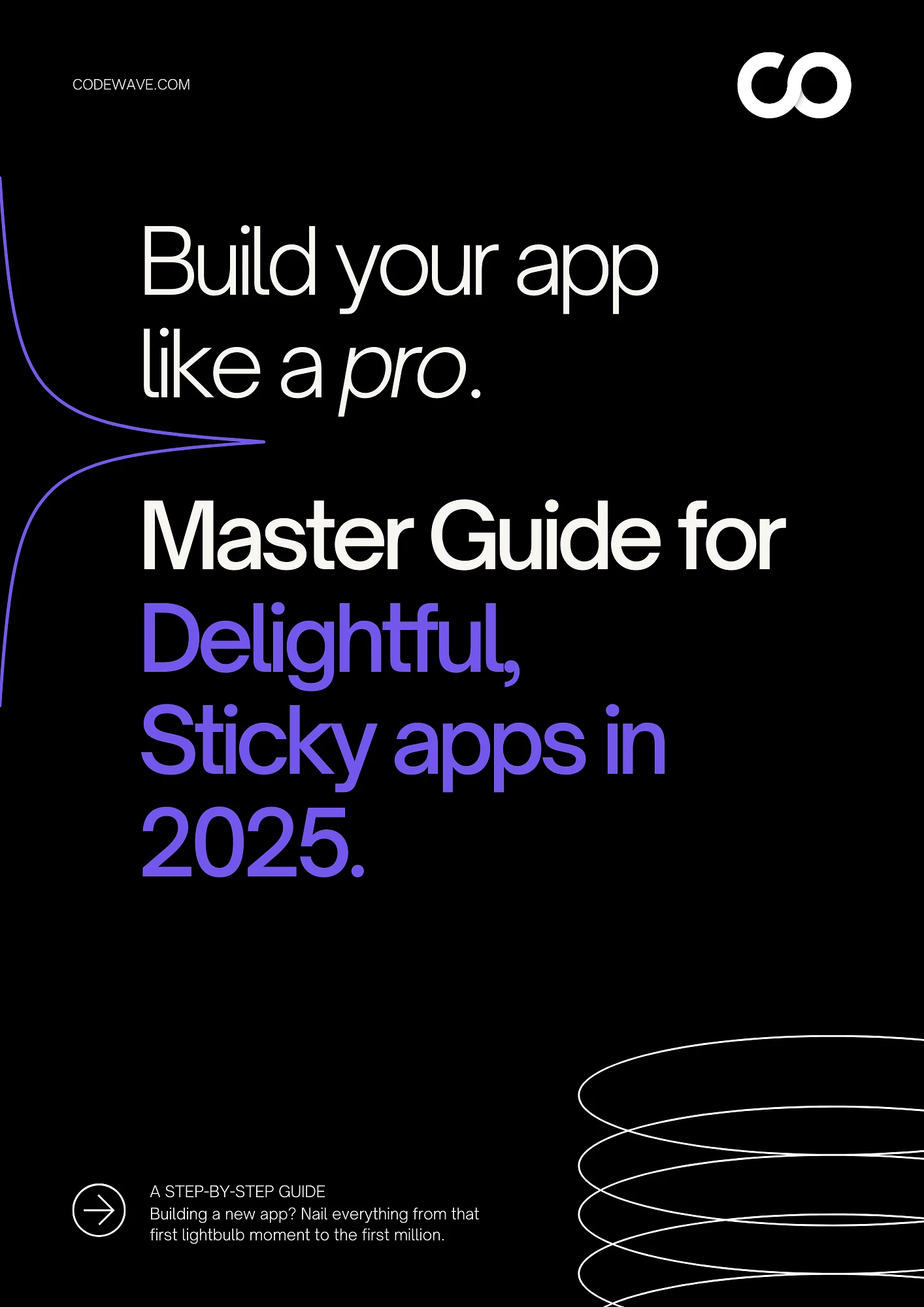What’s on the horizon for enterprise software in 2026? The momentum is building around two breakthroughs: AI capabilities that execute end-to-end business workflows, and composable systems you can reconfigure without burning development budgets.
The rapid demand for personalized solutions paints a clear picture. The global custom software development market is set to jump from $43.16 billion in 2024 to $146.18 billion by 2030. Innovation-focused teams are investing in adaptability now.
They want platforms that bend to their workflow reality instead of forcing everyone into standardized boxes.
Here, we’re breaking down 10 key patterns, touching on autonomous systems, modular design, and security approaches built for speed.
Key Takeaways
- AI agents now handle complete workflows autonomously, making decisions and correcting errors without human intervention, with 23% of organizations already scaling these systems across their operations.
- Composable architecture lets you swap software components like Lego blocks, eliminating vendor lock-in and reducing costs by paying only for the tools you need instead of bloated enterprise suites.
- 78% of organizations adopted AI in 2024, up from 55% the previous year, as embedded intelligence becomes standard in everyday applications rather than separate add-on tools.
- Zero trust security assumes breaches will happen and verifies every access request continuously, with 63% of global organizations now implementing this approach to limit damage from attacks.
- The custom software market will surge from $43.16 billion in 2024 to $146.18 billion by 2030, driven by demand for adaptable systems that bend to unique workflows.
10 Enterprise Software Trends in 2026 to Watch Out For
We handpicked these ten based on three factors: how quickly they’re being adopted, the business problems they solve right now, and whether they’ll reshape your operations in the next 18 months.
- AI Agents That Work Independently
Think of AI agents as digital employees who handle complete tasks from beginning to end. Instead of you prompting an AI for every single step, these agents take an instruction like “process these vendor invoices” and figure out the entire workflow themselves.
They decide what needs to happen, execute each step, check their own work, and only loop you in when something needs your judgment.
Nearly a quarter of organizations are already scaling these agentic systems across their enterprises, and that number is climbing fast. It’s the difference between micromanaging and delegating to someone you trust.
Noteworthy Features:
- Autonomous decision-making: These agents evaluate situations and choose the best course of action without waiting for you to tell them what to do next.
- Multi-step execution: They break complex tasks into smaller actions, complete each one in sequence, and track progress until the entire job is finished properly.
- Self-correction capabilities: When something goes wrong or the results look off, the agent identifies the issue, adjusts its approach, and tries again without human intervention.
- Cross-platform integration: They move seamlessly between your different software tools, pulling data from one system and pushing updates to another as needed.
- Learning from outcomes: Every task they complete helps them get better at similar work, so their performance improves the more you use them.
- Composable Architecture
Composable architecture means building your software stack like Lego blocks instead of buying monolithic platforms that do everything poorly. You pick best-in-class components for each function – one for customer data, another for billing, another for analytics, and connect them through APIs.
When your needs change or better tools emerge, you swap out individual pieces without rebuilding everything. It gives you the flexibility to evolve your tech stack as quickly as your business changes.
Noteworthy Features:
- Plug-and-play components: Each piece of software connects easily to others through standard interfaces, so you’re not locked into one vendor’s entire ecosystem.
- Faster deployment cycles: Since you’re working with smaller, focused components, you can launch new capabilities in weeks instead of waiting months for enterprise implementations.
- Reduced vendor lock-in: When one tool stops serving you well, you replace just that piece rather than ripping out your entire system and starting over.
- Customized tech stacks: You build exactly what your business needs instead of paying for bloated platforms packed with features you’ll never touch or use.
- Lower total cost: You only pay for components you need, and competition between specialized vendors keeps pricing reasonable compared to all-in-one enterprise suites.
- Embedded AI Everywhere
Embedded AI means intelligence woven directly into every application you already use, not separate chatbots you visit when stuck. Your CRM suggests the next best action for each customer. Your project management tool predicts which deadlines will slip. Your spreadsheet explains patterns in your data before you even ask.
The adoption curve tells the story clearly: 78% of organizations reported using AI in 2024, jumping from 55% the year before, according to a Stanford report. As AI continues to mature, it’s set to play a central role across industries, from healthcare to finance.
Noteworthy Features:
- Contextual suggestions: The AI understands what you’re working on right now and offers relevant help based on your current task, not generic recommendations.
- Predictive insights: It spots patterns in your workflow and warns you about potential problems before they become expensive mistakes you have to fix later.
- Natural language interactions: You ask questions in plain English instead of learning complex query languages or digging through endless menus to find answers.
- Automated routine tasks: Repetitive work happens in the background without you clicking through the same sequences, freeing your time for decisions that need judgment.
- Personalized experiences: The system learns how you work and adapts its interface and suggestions to match your preferences and habits over time.
- Platform Engineering
Platform engineering means creating internal systems that make your developers wildly more productive instead of drowning in infrastructure headaches.
Your platform team builds standardized tools, workflows, and templates so developers can spin up new projects in minutes rather than weeks.
They handle the complexity of cloud infrastructure, security protocols, and deployment pipelines so your engineering team focuses on building features customers care about instead of wrestling with DevOps configurations.
Noteworthy Features:
- Self-service infrastructure: Developers provision resources, deploy code, and manage environments through simple interfaces without filing tickets or waiting for operations teams to help.
- Standardized workflows: Everyone follows consistent processes for testing, deployment, and monitoring, which reduces errors and makes collaboration smoother across different team members.
- Built-in guardrails: Security and compliance requirements are baked into the platform, so developers build correctly by default rather than breaking things they didn’t know about.
- Golden paths: Pre-configured templates for common tasks let developers start new projects with best practices already in place instead of reinventing the wheel each time.
- Unified observability: One dashboard shows how all your systems are performing, making it easy to spot and fix issues before they impact customers or revenue.
- Zero Trust Security
Zero-trust security operates on one principle: trust nothing and verify everything, even inside your network perimeter. Every person, device, and application proves its identity and authority before accessing any resource, every single time.
It’s like having a security checkpoint at every door in your building instead of just the front entrance. This approach assumes breaches will happen and limits damage by making sure attackers can’t move freely through your systems once they’re in.
According to Gartner, Inc., 63% of organizations globally have either fully or partially adopted a zero-trust strategy.
Noteworthy Features:
- Continuous verification: Users and devices prove they’re legitimate with each access request, not just once when logging in at the start of their day.
- Least privilege access: Everyone gets only the minimum permissions they need for their specific role, nothing more, reducing what attackers can reach if credentials get compromised.
- Micro-segmentation: Your network is divided into small, isolated zones so a breach in one area can’t spread freely to everything else you’re protecting.
- Context-aware policies: Access decisions consider factors like device health, location, time of day, and user behavior patterns before granting permission to sensitive resources.
- Assumed breach mindset: The system is designed expecting that someone will eventually get in, so monitoring and response mechanisms catch suspicious activity quickly.
- AI-Powered Development Tools
AI-powered development tools are changing how software gets built by handling the tedious parts of coding that eat up developer time.
These tools write boilerplate code, suggest complete functions based on what you’re trying to accomplish, catch bugs before they reach production, and even refactor messy code into cleaner versions.
Developers stay focused on solving business problems and making architectural decisions while AI handles the repetitive typing and pattern-matching that computers do better than humans anyway.
Noteworthy Features:
- Code generation: The AI writes complete functions and classes based on your description of what you need, handling syntax and structure automatically.
- Intelligent debugging: It analyzes errors, suggests likely causes, and often proposes fixes that solve the problem without you digging through documentation or Stack Overflow.
- Automated testing: The system generates test cases for your code, identifies edge cases you might miss, and ensures changes don’t break existing functionality unexpectedly.
- Code review assistance: AI reviews pull requests for common issues, security vulnerabilities, and style inconsistencies before human reviewers spend their time on it.
- Documentation generation: It creates clear explanations of what code does and how to use it, keeping documentation current as the codebase evolves.
- Real-Time Data Processing
Real-time data processing means analyzing information and taking action the moment it arrives, not hours or days later in batch reports. Your system spots a customer struggling on your website and triggers an immediate support offer.
It detects unusual transaction patterns and blocks potential fraud before money moves. It adjusts inventory levels as sales happen, not after you’ve already run out of stock.
Speed turns data from historical records into something that changes outcomes while situations are still unfolding.
Noteworthy Features:
- Stream processing: Data flows continuously through your systems and gets analyzed instantly as it arrives, rather than collecting in databases waiting for scheduled processing.
- Event-driven actions: The system automatically responds to specific triggers or patterns without human intervention, making decisions at machine speed instead of business-hours speed.
- Low-latency analytics: You see insights within milliseconds of data generation, enabling split-second decisions in pricing, fraud prevention, or operational adjustments that affect outcomes.
- Continuous intelligence: AI models evaluate every data point in real-time, learning and adapting as conditions change rather than training periodically on stale information.
- Immediate feedback loops: Actions taken based on real-time data create new data that refines future decisions, creating systems that get smarter with every interaction.
- API-First Design
API-first design means building every piece of software with integration as the starting point, not an afterthought. Before creating user interfaces or internal features, teams design clean APIs that other systems can easily connect to.
This approach ensures your software plays well with others from day one. Whether you’re linking internal tools or collaborating with partner platforms, everything works without a hitch.
By prioritizing interoperability from the outset, you provide customers with the flexibility to build on your infrastructure.
Noteworthy Features:
- Standardized interfaces: Every function and data source exposes itself through consistent, well-documented APIs that developers can understand and use without lengthy onboarding or confusion.
- Ecosystem ready: Third-party tools and custom integrations connect easily to your systems, creating networks of capabilities that extend far beyond what you built alone.
- Mobile and web parity: Both mobile apps and web applications use the same APIs, ensuring feature consistency and reducing the work needed to maintain them.
- Versioning built-in: As APIs evolve, old versions keep working, so existing integrations don’t break while new capabilities roll out to those who want them.
- Developer experience focus: APIs are designed to be intuitive and easy to work with, treating developers as customers who deserve thoughtful, frictionless experiences.
- Vertical AI Solutions
Vertical AI solutions are purpose-built for specific industries instead of trying to serve everyone with generic tools. A healthcare AI understands medical terminology, insurance workflows, and compliance requirements.
A manufacturing AI knows production scheduling, supply chain logistics, and quality control processes. These specialized systems deliver better results faster because they’re trained on industry-specific data and designed around problems unique to that field.
You don’t need to waste time anymore teaching general AI about your domain.
Noteworthy Features:
- Industry-specific training: Models learn from data and scenarios relevant to your field, so they understand context and terminology that general AI would miss completely.
- Pre-built workflows: Common processes in your industry come configured out of the box, reducing implementation time from months to weeks and delivering value immediately.
- Regulatory compliance: Built-in guardrails ensure the AI operates within industry regulations and standards, protecting you from expensive mistakes or legal exposure that comes from violations.
- Domain expertise embedded: The system incorporates best practices and knowledge from industry experts, giving you institutional wisdom without hiring expensive consultants or building it yourself.
- Specialized integrations: Connectors to industry-standard tools and platforms work seamlessly, since the solution was designed specifically for the ecosystem you already operate within.
- Sustainable Computing
Sustainable computing focuses on reducing the environmental impact of your technology operations while often cutting costs at the same time.
It means choosing energy-efficient cloud regions, optimizing code so it uses less processing power, shutting down idle resources instead of letting them run 24/7, and measuring the carbon footprint of your digital infrastructure.
As regulations tighten and customers care more about environmental responsibility, sustainable computing shifts from nice-to-have to a business requirement that affects your bottom line and reputation.
Noteworthy Features:
- Carbon-aware scheduling: Workloads automatically run when and where renewable energy is available, reducing emissions without you manually managing power sources or timing.
- Resource optimization: Systems identify and eliminate waste like oversized servers, redundant storage, and inefficient code that burns energy without delivering proportional value to users.
- Green cloud selection: Tools help you choose data centers powered by renewable energy and measure the environmental impact of different hosting decisions before committing.
- Energy consumption tracking: Detailed dashboards show exactly how much power your applications use, making it easy to spot inefficiencies and prove progress toward sustainability goals.
- Efficient architecture patterns: Design approaches that minimize computational overhead and data transfer, reducing both your cloud bill and environmental footprint simultaneously through smart technical choices.
Conclusion
The software landscape in 2026 rewards companies that build for adaptability rather than permanence. These ten trends aren’t isolated shifts but interconnected movements toward systems that think, connect, and evolve alongside your business.
The winners won’t be those with the biggest tech budgets but those who invest strategically in tools that compound their competitive advantages. Your next software decision shapes whether you’re leading change or scrambling to catch up.
At Codewave, we help SMEs adopt these transformations without the guesswork or expensive missteps.
We build custom software solutions that integrate these emerging trends into your existing operations, ensuring you adopt what moves your business forward rather than chasing every shiny new tool.
We’ve guided companies through AI implementation, composable architecture builds, and security overhauls that actually stick. Here’s how we make it happen:
- Strategic technology audits: We assess your current stack against these trends, identify gaps costing you money or speed, and create actionable roadmaps that prioritize high-impact changes over trendy additions.
- Custom AI integration: We embed intelligent automation into your workflows where it delivers measurable returns, avoiding the trap of AI theater that looks impressive but solves nothing meaningful for your operations.
- Composable system design: We architect flexible tech stacks using best-in-class components tailored to your needs, giving you the agility to adapt without vendor lock-in or expensive rebuilds down the road.
- Security-first development: We build zero trust principles into every solution from day one, protecting your data and reputation while keeping your teams productive and your customers confident in your platform.
- End-to-end implementation support: We don’t just design and disappear—our team stays with you through deployment, training, and optimization to ensure your investment delivers the business outcomes you’re counting on.
Ready to future-proof your enterprise software? Book for a 15-minute free strategy session to explore which of these trends will create the biggest impact for your specific business challenges and goals.
Frequently Asked Questions
- What are the most important enterprise software trends in 2026?
The top trends include AI agents that work independently, composable architecture for flexible tech stacks, embedded AI in everyday applications, platform engineering for developer productivity, and zero trust security. Real-time data processing, API-first design, and vertical AI solutions are also reshaping how businesses operate.
- How is AI changing enterprise software?
AI is shifting from standalone chatbots to intelligence embedded directly in your workflows. Agents now handle complete tasks autonomously, from processing invoices to managing customer interactions. They learn from outcomes, make decisions independently, and only involve humans when judgment calls are needed.
- What is composable architecture and why does it matter?
Composable architecture means building your tech stack from best-in-class components that connect through APIs instead of buying monolithic platforms. You can swap individual pieces as needs change without rebuilding everything, giving you flexibility and reducing both costs and vendor lock-in.
- Why is zero trust security becoming essential?
Zero trust assumes breaches will happen and requires continuous verification for every access request, even inside your network. With 63% of organizations already adopting this approach, it’s becoming essential because traditional perimeter security can’t stop attackers from moving freely once they’re inside your systems.
- How much is the enterprise software market expected to grow?
The global custom software development market is projected to grow from $43.16 billion in 2024 to $146.18 billion by 2030. This growth reflects increasing demand for adaptable, personalized solutions that fit unique business workflows rather than forcing companies into standardized platforms.
Codewave is a UX first design thinking & digital transformation services company, designing & engineering innovative mobile apps, cloud, & edge solutions.






![12 Best Company Database Software in 2026 [Updated List]](https://codewave.com/insights/wp-content/uploads/2025/11/9d3021be-f11e-484b-ae91-8532c2282c97-800x500.jpg)
